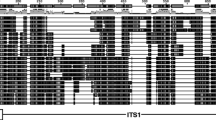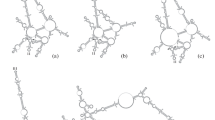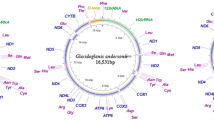Abstract
Freshwater sponges include six extant families which belong to the suborder Spongillina (Porifera). The taxonomy of freshwater sponges is problematic and their phylogeny and evolution are not well understood. Sequences of the ribosomal internal transcribed spacers (ITS1 and ITS2) of 11 species from the family Lubomirskiidae, 13 species from the family Spongillidae, and 1 species from the family Potamolepidae were obtained to study the phylogenetic relationships between endemic and cosmopolitan freshwater sponges and the evolution of sponges in Lake Baikal. The present study is the first one where ITS1 sequences were successfully aligned using verified secondary structure models and, in combination with ITS2, used to infer relationships between the freshwater sponges. Phylogenetic trees inferred using maximum likelihood, neighbor-joining, and parsimony methods and Bayesian inference revealed that the endemic family Lubomirskiidae was monophyletic. Our results do not support the monophyly of Spongillidae because Lubomirskiidae formed a robust clade with E. muelleri, and Trochospongilla latouchiana formed a robust clade with the outgroup Echinospongilla brichardi (Potamolepidae). Within the cosmopolitan family Spongillidae the genera Radiospongilla and Eunapius were found to be monophyletic, while Ephydatia muelleri was basal to the family Lubomirskiidae. The genetic distances between Lubomirskiidae species being much lower than those between Spongillidae species are indicative of their relatively recent radiation from a common ancestor. These results indicated that rDNA spacers sequences can be useful in the study of phylogenetic relationships of and the identification of species of freshwater sponges.



Similar content being viewed by others
References
Addis JS, Peterson KJ (2005) Phylogenetic relationships of freshwater sponges (Porifera, Spongillina) inferred from analyses of 18S rDNA, COI mtDNA, and ITS2 rDNA sequences. Zool Scr 34:549–557
Altschul SF, Madden TL, Schaffer AA, Zhang J, Zhang Z, Miller W, Lipman DJ (1997) Gapped BLAST and PSI-BLAST: a new generation of protein database search programs. Nucleic Acids Res 25:3389–3402
Bargues MD, Vigo M, Horak P, Dvorak J, Patzner RA, Pointier JP, Jackiewicz M, Meier-Brook C, Mas-Coma S (2001) European Lymnaeidae (Mollusca: Gastropoda), intermediate hosts of trematodiases, based on nuclear ribosomal DNA ITS-2 sequences. Infect Genet Evol 1(2):85–107
Bargues MD, Horak P, Patzner RA, Pointier JP, Jackiewicz M, Meier-Brook C, Mas-Coma S (2003) Insights into the relationships of Palearctic and Nearctic lymnaeids (Mollusca: Gastropoda) by rDNA ITS-2 sequencing and phylogeny of stagnicoline intermediate host species of Fasciola hepatica. Parasite 10(3):243–255
Berg LS (1910) Baikalian fauna and its origin. Biol J 1(1):10–45 (in Russian)
Borchiellini C, Chombard C, Manuel M, Alivon E, Vacelet J, Boury-Esnault N (2004) Molecular phylogeny of Demospongiae: implications for classification and scenarios of character evolution. Mol Phylogenet Evol 32:823–837
Brien P (1970) Les Potamolepides africaines nouvelles du Luapula et du Lac Moero. Symp Zool Soc Lond 25:163–186
Coleman AW (2003) ITS2 is a double-edged tool for eukaryote evolutionary comparisons. Trends Genet 19(7):370–375
Coleman AW (2007) Paneukaryote ITS2 homologies revealed by RNA secondary structure. Nucleic Acids Res 35:3322–3329
Coleman AW, Vacquier VD (2002) Exploring the phylogenetic utility of ITS sequences for animals: a test case for abalone (haliotis). J Mol Evol 54(2):246–257
Coleman AW, Preparata RM, Mehrotra B, Mai JC (1998) Derivation of the secondary structure of the ITS-1 transcript in Volvocales and its taxonomic correlations. Protist 149:135–146
Duran S, Giribet G, Turon X (2004) Phylogeographical history of the sponge Crambe crambe (Porifera, Poecilosclerida): range expansion and recent invasion of the Macaronesian islands from the Mediterranean Sea. Mol Ecol 13:109–122
Efremova SM (2001) Sponges (Porifera). In: Timoshkin OA (ed) Index of animal species inhabiting lake Baikal and its catchment area, vol. 1. Lake Baikal, Book 1. Nauka, Novosibirsk, pp 182–192 (in Russian)
Efremova SM (2004) New genus and new species of sponges from family Lubomirskiidae Rezvoj, 1936. In: Timoshkin OA (ed) Index of animal species inhabiting lake Baikal and its catchement area, vol. 1, Lake Baikal, Book 2. Nauka, Novosibirsk, pp 1261–1278
Efremova SM, Goureeva MA (1989) The problem of the origin and evolution of Baikalian sponges. 1st Vereshchagin Baikal Int. Conf. Abstracts, Irkutsk, pp 21–22
Efremova SM, Itskovich VB, Parfenova V, Drucker VV, Müller WEG, Schröder HC (2002) Lake Baikal: a unique place to study evolution of sponges and their stress response in an environment nearly unimpaired by anthropogenic perturbation. Cell Mol Biol 48(4):359–371
Felsenstein J (1985) Confidence limits on phylogenies: an approach using the bootstrap. Evolution 39:783–791
Galtier N, Gouy M, Gautier C (1996) SEAVIEW and PHYLO_WIN: two graphic tools for sequence alignment and molecular phylogeny. Comp Appl Biosci 12:543–548
Goertzen LR, Cannone JJ, Gutell RR, Jansen RK (2003) ITS secondary structure derived from comparative analysis: implications for sequence alignment and phylogeny of the Asteraceae. Mol Phylogenet Evol 29:216–234
Gustincich SG, Manfioletti G, Del Sal C, Schneider Carnincy P (1991) A fast method for high-quality genomic DNA extraction from whole human blood. Biotechniques 11:298–300
Hall TA (1999) BioEdit: a user-friendly biological sequence alignment editor and analysis program for Windows 95/98/NT. Nucleic Acids Symp Ser 41:95–98
Hooper JNA, van Soest RWM (2002) Class Demospongiae Sollas, 1885. In: Hooper JNA, van Soest RWM (eds) Systema Porifera: a guide to the classification of sponges, vol 1. Kluwer Academic/Plenum, New York, pp 15–18
Huelsenbeck JP, Ronquist F (2001) MRBAYES: Bayesian inference of phylogeny. Bioinformatics 17:754–755
Itskovich VB, Belikov SI, Efremova SM, Masuda Y (1999) Phylogenetic relationship between Lubomirskiidae, Spongillidae and some marine sponges according partial sequences of 18S rDNA. Mem Queensland Mus 44:275–280
Itskovich VB, Belikov SI, Efremova SM, Masuda Y, Krasko A, Schroder HC, Muller WEG (2006) Monophyletic origin of freshwater sponges in ancient lakes based on partial structures of COXI gene. Hydrobiologia 568(1):155–159
Itskovich VB, Belikov SI, Efremova SM, Masuda Y, Perez T, Alivon E, Borchiellini C, Boury-Esnault N (2007) Phylogenetic relationships between freshwater and marine Haplosclerida (Porifera, Demospongiae) based on the full length 18S rRNA and partial COXI gene sequences. In: Custódio MR, Hajdu E, Lôbo-Hajdu G, Muricy G (eds) Porifera research: biodiversity, innovation and sustainability. Museu Nacional, Rio de Janeiro, pp 383–391
Joseph N, Krauskopf E, Vera MI, Michot B (1999) Ribosomal internal transcribed spacer 2 (ITS2) exhibits a common core of secondary structure in vertebrates and yeast. Nucleic Acids Res 27:4533–4540
Kaygorodova IA, DYu Sherbakov, Martin P (2007) Molecular phylogeny of Baikalian Lumbriculidae (Oligochaeta): evidence for recent explosive speciation. Comp Cytogenet 1(1):71–84
Kimura M (1980) A simple method for estimating evolutionary rate of base substitutions through comparative studies of nucleotide sequences. J Mol Evol 16:111–120
Kumar S, Tamura K, Jakobsen IB, Nei M (2001) MEGA2: molecular evolutionary genetics analysis software. Bioinformatics 17(12):1244–1245
Mai JC, Coleman AW (1997) The internal transcribed spacer 2 exhibits a common secondary structure in green algae and flowering plants. J Mol Evol 44:258–271
Makushok ME (1925) To the question of origin of Lake Baikal spongiofauna. Russ Zool J 5(4):50–73 (in Russian)
Manconi R, Pronzato R (2002) Suborder Spongillina subord. nov.: freshwater sponges. In: Hooper JNA, van Soest RWM (eds) Systema Porifera: a guide to the classification of sponges, vol 1. Kluwer Academic/Plenum, New York, pp 921–1019
Marshall W (1885) On some new siliceous sponges collected by M. Pechuel-Losche in the Kongo. Ann Mag Nat Hist 12:391–412
Martinson GG (1940) Materials for the study of the fossil fauna of the Baikal area. Trudy Baikalskoi Limnolicheskoi Stantsii Acad Sci USSR 10:425–451 (in Russian)
Masuda Y, Satoh K (1992) Scanning electron microscopic observations on spicules, gemmule coats, and micropyles of the freshwater sponge, Eunapius sinensis (Annandale). Kawasaki Igakkai Shi Liberal Arts Sci Course 18:75–82
Masuda Y, Itskovich V, Veinberg EV, Efremova SM (1999) Perspective studies of freshwater sponges in Lake Baikal. Berliner Geowiss Abh 30:329–332
Mats VD (1993) The structure and development of the Baikal rift depression. Earth Sci Rev 34:81–118
Meixner MJ, Luter C, Eckert C, Itskovich V, Janussen D, von Rintelen T, Bohne AV, Meixner JM, Hess WR (2007) Phylogenetic analysis of freshwater sponges provide evidence for endemism and radiation in ancient lakes. Mol Phylogenet Evol 45(3):875–886
Nichols SA (2005) An evaluation of support for order-level monophyly and interrelationships within the class Demospongiae using partial data from the large subunit rDNA and cytochrome oxidase subunit I. Mol Phylogenet Evol 34:81–96
Nielsen C (2001) Animal evolution. Interrelationships of the living phyla, 2nd edn. Oxford University Press, Oxford
Penney JT, Racek AA (1968) Comprehensive revision of a worldwide collection of freshwater sponges (Porifera: Spongillidae). Bull US Natl Mus 272:1–184
Posada D, Crandall KA (1998) MODELTEST: testing the model of DNA substitution. Bioinformatics 14(9):817–818
Pronzato R, Manconi R (2001) Atlas of European freshwater sponges. Ann Mus Civ St Nat Ferrara 4(3):64
Racek AA, Harrison FW (1974) The systematic and phylogenetic position of Palaeospongilla chubutensis (Porifera, Spongillidae). Proc Linn Soc New South Wales 99(3):157–165
Redmond NE, van Soest RW, Kelly M, Raleigh J, Travers SA, McCormack GP (2007) Reassessment of the classification of the order Haplosclerida (class Demospongiae, phylum Porifera) using 18S rRNA gene sequence data. Mol Phylogenet Evol 43:344–352
Resenchuk SM (1991) Gene Tools (preparation and processing of text files containing the nucleic or amino acids sequences). Version 1.0
Rezvoi PD (1936) Freshwater sponges of the USSR. In: Rezvoi PD (ed) The fauna of the USSR, vol 2. AS USSR, Moskow, pp 1–42 (in Russian)
Ronquist F, Huelsenbeck JP (2003) MrBayes 3: Bayesian phylogenetic inference under mixed models. Bioinformatics 19(12):1572–1574
Sambrook J, Fritsch EF, Maniatis T (1989) Molecular cloning: a laboratory manual. Cold Spring Harbor Laboratory, Cold Spring Harbor, NY
Schmidt HA, Strimmer K, Vingron M, von Haeseler A (2000) TREE-PUZZLE: maximum likelihood phylogenetic analysis using quartets and parallel computing. Bioinformatics 18(3):502–504
Schmitt S, Hentschel U, Zea S, Dandekar T, Wolf M (2005) ITS-2 and 18S rRNA gene phylogeny of Aplysinidae (Verongida, Demospongiae). J Mol Evol 60(3):327–336
Schröder HC, Efremova SM, Itskovich VB, Belikov SI, Masuda Y, Krasko A, Müller IM, Müller WEG (2003) Molecular phylogeny of the freshwater sponges in Lake Baikal. J Zool Syst Evol Res 41:80–86
Sherbakov DY (1999) Molecular phylogenetic studies on the origin of biodiversity in Lake Baikal. Trends Ecol Evol 14:92–94
Sperling EA, Pisani D, Peterson KJ (2007) Poriferan paraphyly and its implications for Precambrian paleobiology. Geol Soc Lond Spec Publ 286:355–368
Swofford DL (2002) PAUP*. Phylogenetic Analysis Using Parsimony (*and other methods). Sinauer Associates, Sunderland MA
Thompson JD, Higgins DG, Gibson TJ (1994) CLUSTAL W: improving the sensitivity of progressive multiple sequence alignment through sequence weighting, positions-specific gap penalties and weight matrix choice. Nucleic Acids Res 22:4673–4680
Timoshkin OA (ed) (1995) Index of animal species inhabiting Lake Baikal and its catchement area. Vol. 1. Lake Baikal, Book 2. Nauka, Novosibirsk, pp 1261–1278
van Nues RW, Rientjes JMJ, van Dersande CAFM, Zerp SF, Sluiter C, Venema J, Planta RJ, Raue HA (1994) Separate structural elements within internal transcribed spacer-1 of Saccharomyces cerevisiae precursor ribosomal RNA direct the formation of 17S and 26S ribosomal RNA. Nucleic Acids Res 22:912–919
Vereshchagin GY (1940) The origin and the history of Baikal, its fauna and flora. Trudi Baikalskoy Limnol Stanzcii AS USSR 10:73–239 (in Russian)
Volkmeir-Ribeiro C (1990) A new insight into the systematics, evolution and taxonomy of freshwater sponges. In: Rutzler K (ed) New perspectives in sponge biology. Smithsonian Institution Press, Washington, DC, pp 323–331
Volkmer-Ribeiro C, de Rosa-Barbosa R (1978) Neotropical freshwater sponges of the family Potamolepidae Brien, 1967. In: Levi C, Boury Esnault N (eds) Biologie des Spongiaires. Colloques Internationaux No. 291. Centre National de la Recherche Scientifique, Paris, pp 503–511
Volkmer-Ribeiro C, Watanabe Y (1983) Sanidastra yokotonensis, n. gen. and n. sp. of freshwater sponge from Japan. Bull Natl Sci Mus Tokyo Zool 9:151–159
Weinberg EV (2001) The sponge fauna of Lake Baikal in the Late Pliocene (according to studies of core samples from deep borehole BDP-96–1). Russ Geol Geophys 42(1–2):130–137
Wilkinson CR (1978) Microbial associations in sponges. II. Numerical analysis of sponge and water bacterial populations. Mar Biol 49:169–176
Willmer P (1990) Invertebrate relationships. Patterns in animal evolution. Cambridge University Press, Cambridge
Wolf M, Achtziger M, Schultz J, Dandekar T, Muller T (2005) Homology modelling revealed more than 20, 000 rRNA internal transcribed spacer 2 (ITS2) secondary structures. RNA 11:1616–1623
Wörheide G, Hooper JN, Degnan BM (2002) Phylogeography of western Pacific Leucetta ‘chagosensis’ (Porifera: Calcarea) from ribosomal DNA sequences: implications for population history and conservation of the Great Barrier Reef World Heritage Area (Australia). Mol Ecol 11(9):1753–1768
Wörheide G, Nichols SA, Goldberg J (2004) Intragenomic variation of the rDNA internal transcribed spacers in sponges (Phylum Porifera): implications for phylogenetic studies. Mol Phylogenet Evol 33(3):816–830
Yoon HS, Lee JY, Boo SM, Bhattacharya D (2001) Phylogeny of Alariaceae, Laminariaceae, and Lessoniaceae (Phaeophyceae) based on plastid-encoded RuBisCo spacer and nuclear-encoded ITS sequence comparisons. Mol Phylogenet Evol 21(2):231–243
Young I, Coleman AW (2004) The advantages of the ITS2 region of the nuclear rDNA cistron for analysis of phylogenetic relationships of insects: a Drosophila example. Mol Phylogenet Evol 30(1):236–242
Zubakov DI, Sherbakov DY, Sitnikova TI (1997) Analysis of phylogeny of endemic mollusca of family Baicaliidae, Clessin 1878 (Gastropoda, Pectinibranchia) from Baikal lake using fragments of nucleotide sequences of the mitochondrial gene CO1. Mol Biol (Mosk) 31(6):1092–1097
Zuker M (2003) Mfold web server for nucleic acid folding and hybridization prediction. Nucleic Acids Res 31(13):3406–3415
Acknowledgments
We thank E. Weinberg and Y. Takemon for help with the collection of samples. This work was supported by an Obuchi fellowship, the Deutsche Forschungsgemeinschaft (DFG 436 RUS/17/20/01), and Federal Agency for Science and Innovations (FASI) Grant MK-4167.2007.4. We also thank G. McCormack for her help with the first version of the text. Two anonymous reviewers are acknowledged for critical comments on the manuscript.
Author information
Authors and Affiliations
Corresponding author
Rights and permissions
About this article
Cite this article
Itskovich, V., Gontcharov, A., Masuda, Y. et al. Ribosomal ITS Sequences Allow Resolution of Freshwater Sponge Phylogeny with Alignments Guided by Secondary Structure Prediction. J Mol Evol 67, 608–620 (2008). https://doi.org/10.1007/s00239-008-9158-5
Received:
Revised:
Accepted:
Published:
Issue Date:
DOI: https://doi.org/10.1007/s00239-008-9158-5




